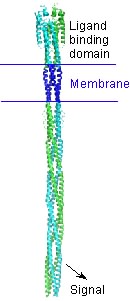Molecular Playground/Bacterial Chemotaxis Receptors
From Proteopedia
One of the CBI Molecules being studied in the University of Massachusetts Amherst Chemistry-Biology Interface Program at UMass Amherst and on display at the Molecular Playground.
Many bacteria can "smell" their surroundings and "choose" where to go. They detect molecules such as amino acids or sugars using receptors that bind these molecules and transmit a signal into the cell. This signal controls several proteins which ultimately control the direction of rotation of the motors that rotate the flagella. One direction causes the cell to continue swimming; the other direction causes the cell to tumble. When an attractant molecule binds, the receptor signals: "Things look good, keep swimming!" The opposite signal occurs when bacteria sense a repellant or less attractant molecules: "Time to tumble and try a new swimming direction."
A bacterial chemotaxis receptor is an unusually long alpha-helical structure. The attractant molecule (the ligand) binds near the top of this picture and sends a signal across the membrane into the cell to control proteins that bind near the bottom. This is a model of the structure of the receptor based on experimental structures of pieces of related proteins.
|
Ligand-binding domain
The spinning protein () ) is the ligand binding domain of the aspartate receptor with the aspartate ligand bound (LKT).
Molecular Playground banner: A bacterial chemotaxis receptor protein used by bacteria to "smell" their environment.
|
Chemotaxis adaptor protein CheW
CheW is a chemotaxis adaptor protein, and part of the tertiary complex formed by the chemotaxis receptor, histidine kinase protein CheA, and CheW. As an adaptor protein, CheW mediates the interaction between the chemotaxis receptor and CheA, and is necessary for the formation of kinase active complexes. CheW has been found to bind to the P5 domain of CheA through crystallographic studies.
At right, CheW is shown with suppression mutants (blue)that have been measured to decrease receptor binding and chemotaxis (SMJ).
Proteopedia Page Contributors and Editors (what is this?)
Lynmarie K Thompson, Michal Harel, Joanne Lau, Shiela M. Jones, Daniel Moyano-Marino

